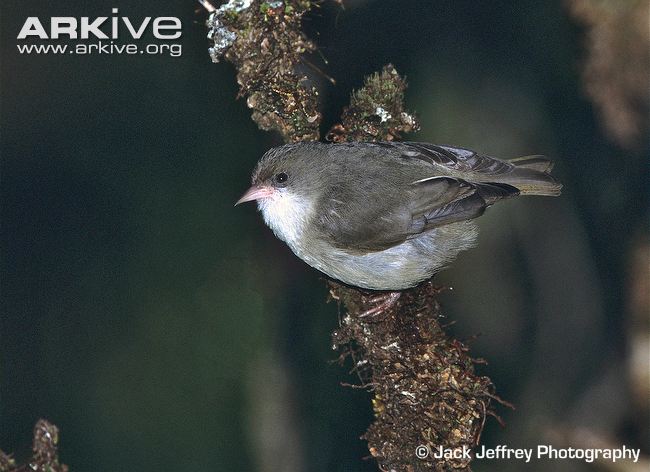
Oreomystis bairdi
TAXONOMY
Oreomystis bairdi Stejneger, 1887.
OTHER COMMON NAMES
English: Kauai creeper; French: Grimpeur de Kauai; German:
Akikiki; Spanish: Akikiki.
PHYSICAL CHARACTERISTICS
4–4.7 in (10–12 cm); 0.4–0.6 oz (11–17 g). Mostly medium
gray with a white belly; short, pink bill; legs and feet are stout
and strong.
DISTRIBUTION
Kauai.
HABITAT
Montane mesic and rainforest above 1,968 ft (600 m).
BEHAVIOR
Lively and active, yet elusive and quiet, moves with a distinctive
creeping motion over tree bark while foraging (thus the
name “creeper”), reminiscent of nuthatches (family Sittidae);
can climb along trunks and branches in any direction. Its unassuming
call is the source of its name.
FEEDING ECOLOGY AND DIET
Feeds mainly on insects and their larvae, spiders, millipedes,
and slugs; nectar and fruit only rarely. Tongue is short, nontubular,
and forked, efficient at snagging and seizing insects
from tight niches, unlike the brush-tipped nectar-lapping
tongues common among honeycreepers. Birds forage singly, in
pairs, or in family groups of up to four individuals. May also
form flocks of up to 12 individuals of same species or in mixed
flocks with anianiau and akeke’e.
REPRODUCTIVE BIOLOGY
Male and female build cup nest of bark and plant fiber for
clutch of two eggs. Previous year’s fledglings often help in raising
their parents’ next brood.
CONSERVATION STATUS
Abundant, but confined to limited area in central Kauai. Listed
as Critically Endangered by IUCN, and of special concern by
the U.S. Fish and Wildlife Service (USFWS).
SIGNIFICANCE TO HUMANS
None known.
Photo Gallery of - Akikiki




 Animalia Life
Animalia Life